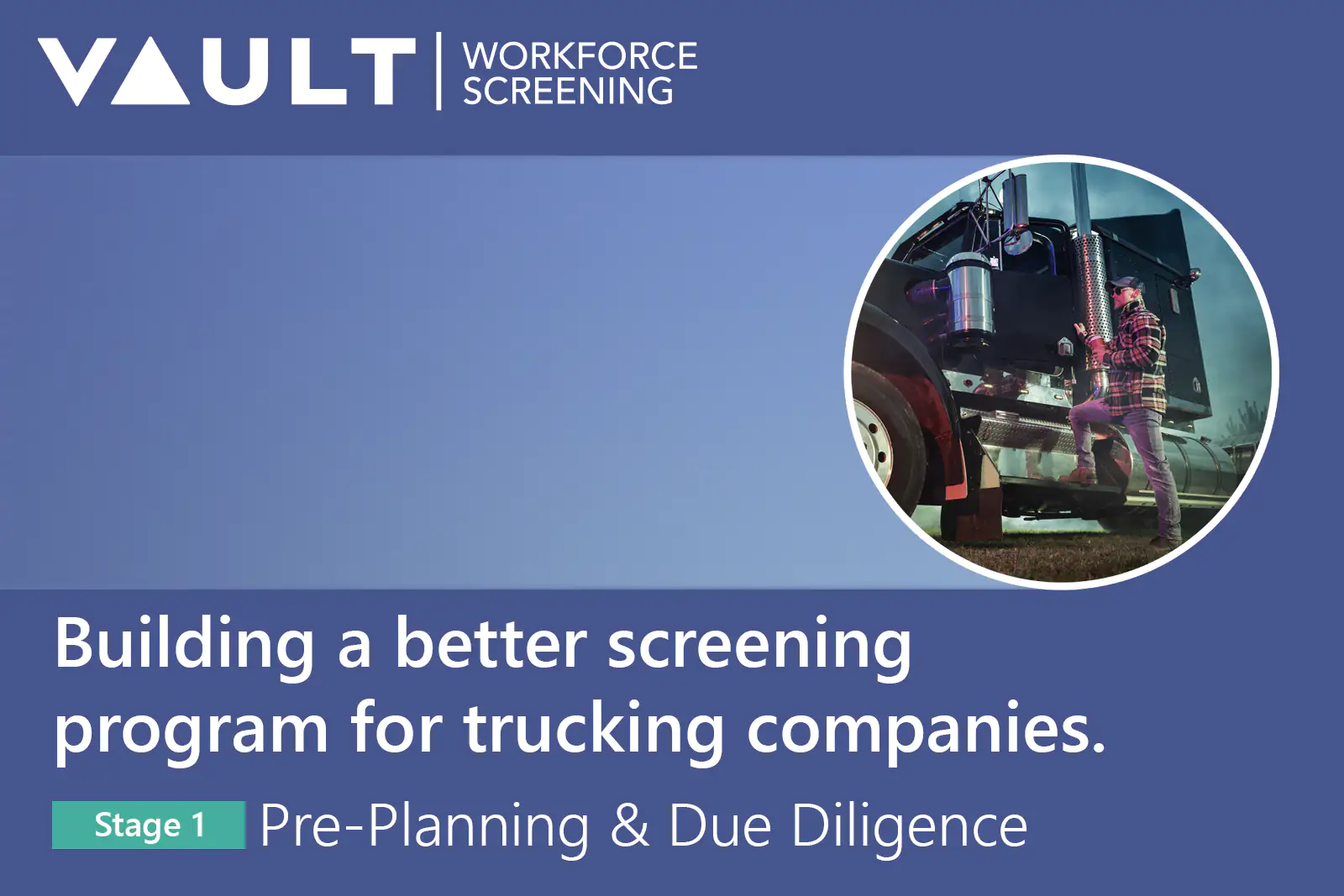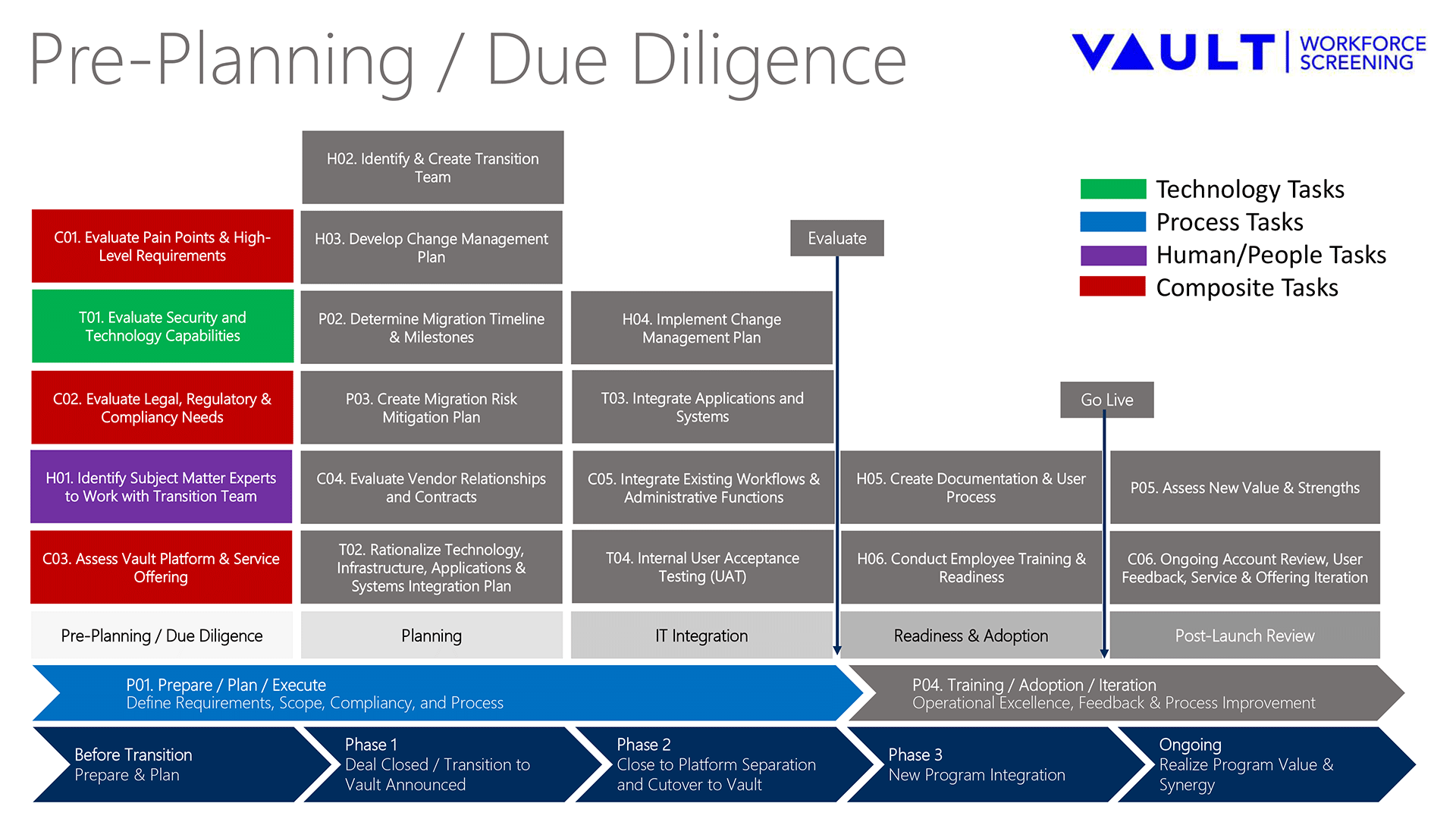Trucking Screening Program: Stage 1- Effective Pre-Planning Strategies
May 4, 2022
The exercise of reviewing your workflows, internal processes, documentation, software platforms, and employee training efforts, is often an eye-opening experience.
Over the next 5 days, we will be covering 19 detailed steps you can (and should) take, throughout 5 clearly defined stages and how you can best approach completely auditing your existing screening program, vetting new vendors, and ultimately rebuilding your program to solve for all you needs.
It will help you understand the big picture and how you can best propose new solutions to optimize HR in your organization. The business case you build will include realistic expectations and clear understanding of resource needs to be successful. Let’s dive in.

Stage 1: Pre-Planning
In the pre-planning stage, you’ll do a lot of the initial heavy lifting, evaluating all aspects of your current screening program, technologies, vendors, workflows, and everyone involved not only in administering your screening program, but also in modifying or implementing new changes.
We’ve broken out this stage into 5 steps:
- Evaluate Pain Points / Requirements:
In this step, you will evaluate pain points with your existing CRA platform and service as well as the effectiveness of your existing screening workflows.
- First, you’ll want to define what “success” looks like from a screening perspective and how that works with your existing talent acquisition workflow. How can you improve today’s “success” by changing platforms, services, and or internal workflows? How can you better build your program to provide a better experience to younger drivers? Be creative here, and make sure to gather input from as many people as you can.
- Second, as part of the exercise in the previous step of defining success, work with the team that currently orders through your existing platform, using your existing processes, and document pain points from both the administrative side and the candidate side of the process. Dig deep here and ask your team to truly list out all areas of opportunity, and or frustrations they have with the screening process.
- Finally, review your corporate screening policy and procedures. Make sure you know the current state of high-level requirements for services needed. These will be used by vendors to help craft a seamless custom solution for your organization.
Vault can help guide you through identifying and documenting pain points and requirements. We are specially trained to spot any potential red flags up front and help you not only transition as quickly and easily as possible but improve your internal screening workflows and candidate experience along the way. At the end of this post, you will find more information about how we can help you through this first phase for free and give you the foundation you need to succeed in your project.
- Evaluate Security & Technology Capabilities
Here, you’ll begin looking at technology capabilities and how they stack up against your organizational requirements.
- First, you’ll want to work with your technology leaders to understand your organization’s technical requirements, including any infrastructure, application, and/or business system integration requirements. Document these in detail.
- Discuss integration options with your screening vendor and find the best solution to meet your organizational needs as defined in the previous step.
- Review any security requirements your organization may have and discuss these versus the capabilities of the technology platform you are looking to migrate to.
Although it may seem very early in the process to begin evaluating technology and security, these often creep up on you late in the game and cause undue delays or even halts to moving forward with a project. By getting this aspect of dud diligence out of the way early on, you’ll avoid issues later down the road. Vault can work with your IT team to make sure the our platform will meet any and all requirements from an integration, infrastructure and security perspective. Vault offers many solutions when it comes to platform usage and integration, and we can go over each in detail during this phase if you would like.
- Evaluate Legal, Regulatory & Compliancy Needs
As with Security & Technology Capabilities, you’ll want to evaluate your legal, regulatory and compliance needs early on in the process. Trucking and Transportation in general have much more regulatory compliance requirements than other industries. Here, you will review your existing screening program and evaluate requirements that must be met, and/or potentially modified in the transition.
- First, you should review your screening program and workflows in detail, documenting any areas where legal compliance is of concern, or specific to your industry or organizational needs. Make sure you are up to date on all current regulatory changes or updates (e.g. FMCSA Clearinghouse changes announces in March).
- Discuss any areas which may need to be modified throughout the transition, and have the final requirements mapped out for your new vendor so they can build the right packages and program for your needs.
Vault’s expert compliance team and your organization to thoroughly review your existing program’s legal compliancy. We will make appropriate recommendations at this time, prior to documenting requirements in detail, and to your migration. Our compliance program includes not only expert compliance advice from Vault, but we have partnered with the industry’s leading legal resources, should there be specialized needs which must be addressed.
- Identify Subject Matter Experts
- Identify Subject Matter Experts (SME’s) from all areas involved in the screening program, whether operational, technical, support, etc. Here you will want to make sure to include everyone who will be involved throughout the process, directly or indirectly, moving forward as well.
- Vault will work with your team to identify all SME’s needed throughout the project. The Transition Team Leader will communicate directly with these SME’s as needed, reducing background noise for unneeded resources in various stages of the migration.
- Assess Vault Workforce Screening Platform, & Service Offering
With business, technical and legal requirements for the transition now in hand, assess the many options Vault offers and plan your custom solution and migration.
- Consolidate and review requirements from all SMEs in human resources, IT, and Legal to match with Enterprise offering options available through Vault.
- Discuss final details and estimated timelines for migration.
Vault will work with you to design a solution that matches your requirements workflows from every angle. We’ll assemble a timeline, and dedicated project file for you to review the real-time progress of migration throughout the project, allowing you to communicate questions, comments or concerns at any point along the way.
Stay tuned for tomorrow's post, where we will share 6 detailed steps you'll take to get through Stage 2: Planning. We'll cover creating the right team to manage the migration, developing your change management plan, Building out a full roadmap with achievable, demonstrable milestones along the way, creating a risk mitigation plan, evaluating existing vendor relationships and contracts, and how you can rationalize technologies, infrastructure, and applications to optimize cost savings, and building a systems integration plan.
Below are links to all stages for this program:
We've mentioned Vault helping you along the way, particularly in this early stage. We are currently offering a free comprehensive 30 minute program review which can help you make sure there are no red flags. A clearly defined program and policy ensures consistency, accuracy, and efficiency in your hiring process. Schedule today and we'll step through every aspect of your program and where you may be able to improve. There is no obligation or risk involved, and you'll receive a free report you can review with team members following the consultation.

The information and opinions expressed are for educational purposes only and are based on current practice, industry related knowledge and business expertise. The information provided shall not be construed as legal advice, express or implied. Consult with legal counsel before any action is taken or not taken in relation to information disseminated in this resource.

